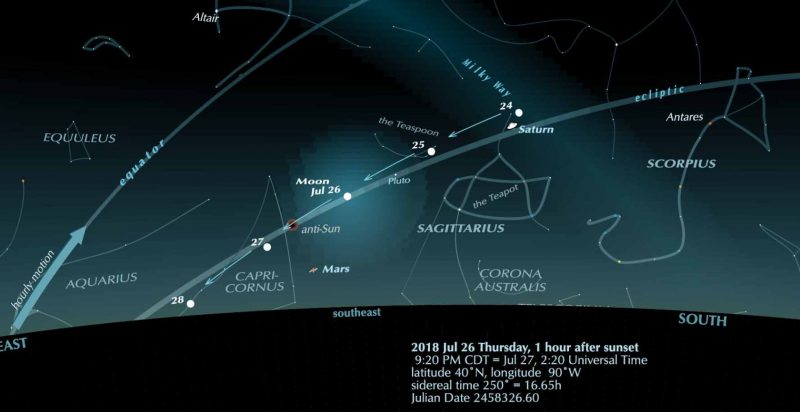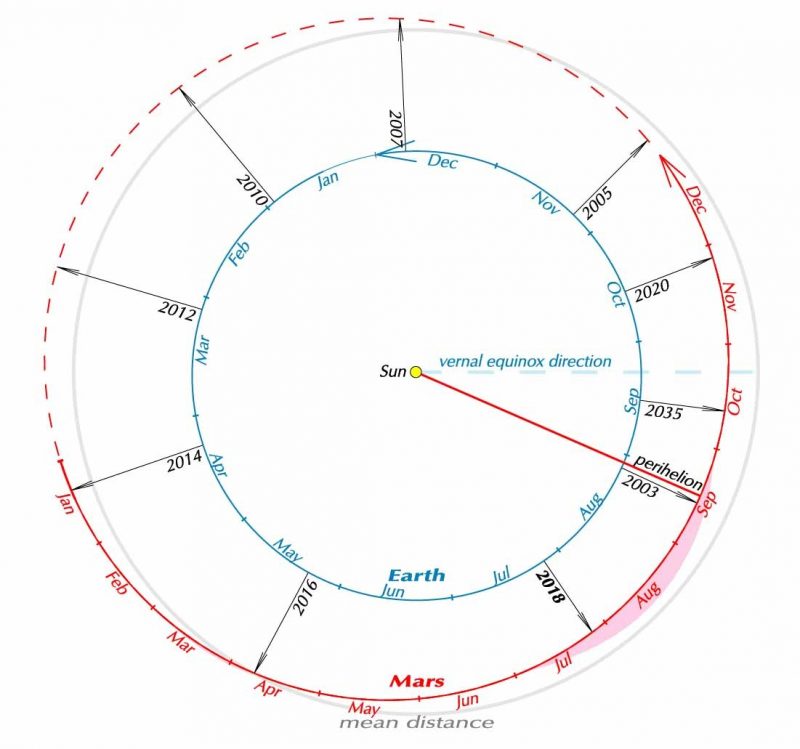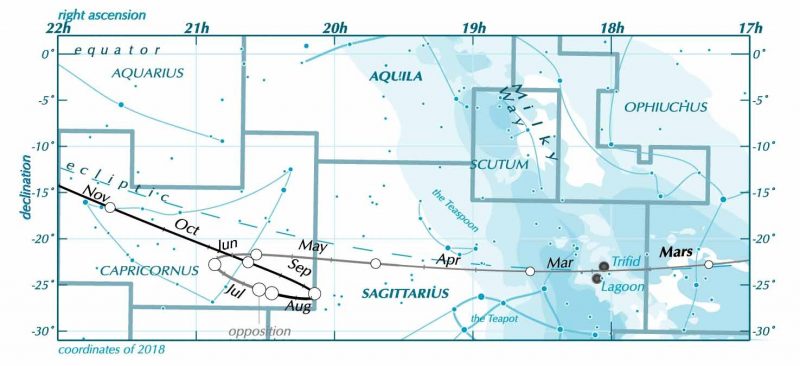
Originally published at Guy Ottewell’s blog and reprinted here with permission.
Mars is at opposition. It is nearest and brightest now, between 2003 and 2035. And the full moon goes into total eclipse – though 15 hours later, so that it is a spectacle for lands around the Indian Ocean and, lower in the sky, for Europe, South America, and Australasia.
That these two events happen only hours apart means that they happen at essentially the same place in the sky. Mars and the moon meet there.
Mars is moving westward (“rightward”) against the starry background, as planets do around the time of opposition because we are overtaking them. The moon, with its far more rapid strides, moves in the contrary direction. They meet near what I call the anti-sun point. This is the center of Earth’s shadow, which is normally invisible but now becomes visible as the moon travels through it.
Let’s deal first with the Mars opposition, which happens first.
A planet is prominent for weeks as we pass nearest to it; the instant of opposition is just the middle of this time, when the planet is 180 degrees from the sun. That instant is July 27 at 05:00 hours UTC, which is 1 a.m. for clocks in eastern North America, midnight by Central time, and on July 26 for zones farther west. So the scene shown above is for America on the evening of July 26, close to the opposition instant.
What is special about the current Mars opposition?

The diagram above is projected on the ecliptic plane. The gray circle is at Mars’s average distance from the sun, about 1.52 astronomical units (or AUs, equal to the sun-Earth distance). In red is Mars’ path for this year. Mars’ orbit is quite elliptical (eccentricity 0.093), in contrast to Earth’s orbit, which is nearly circular. So Mars’ nearest-in point to the sun – perihelion – is only 1.381 AU out.
In the diagram above, arrows connect Earth to Mars at all oppositions from 2003 to 2020, plus the next near-perihelion opposition, in 2035.
Mars oppositions are at intervals of about 2.13 years (this planet’s synodic period). For instance, from the 2016 opposition Mars went all around its orbit and then about another 62 degrees before Earth’s next overtaking of it in 2018. You can see that the jumps on the outer side of the orbit, such as from 2010 to 2012, are shorter than those on the inner side, such as 2018 to 2020, where the planet is speedier.
The quality of the 2018 opposition is that it is only 51 days before Mars reaches perihelion on September 16. Near-perihelic oppositions are the best in that the planet is nearer to us, so appears larger and brighter. They are each 7th or sometimes 8th opposition, at intervals of around 16 years.
At this year’s opposition, the distance from us to Mars is 0.385 A.U. On September 15, 2035, it will be 0.382; on August 14, 2050, it will be only 0.374. But all these are beaten by August 28, 2003: less than 0.373.
2003 was the really special one. That opposition was less than 42 hours before perihelion. To quote my Astronomical Calendar 2003:
The chance of the two phenomena coinciding this or more closely in any 15-year cycle is, I figure shakily, about 1 in 225 … [The distance at minimum is] 0.37272 AU or 55,760,000 kilometers [34,648,000 miles] from us. Various calculators have announced that this is the closest we get to Mars “since the Roman empire” or since 57,537 B.C.! Jean Meeus in his Astronomical Tables (p. 63) says that from 0 to 3000 A.D. the nearest Earth-Mars approach is 0.37200 AU (55,650,000 km [34,579,000 miles]) in 2729.
So Mars this time will by no means break a record. But all perihelic oppositions are good and the differences between them are hardly perceptible; what is good news is how they are in general better than the oppositions on the other side of the orbit. In 2018, the little disk’s apparent width will be 24 arc seconds (as against 25 in 2003 and 2050, and 13 or 14 at aphelic oppositions, taking place when Mars is farthest from the sun). Its brightness will be magnitude -2.8 (as against -2.9 in 2003 and 2050 and -1.2 at aphelic oppositions).
Because of the ellipticity of the orbit, the planet’s nearest moment to us does not exactly coincide with opposition (unless opposition is exactly at perihelion or aphelion). On July 27, Mars is in the part of the orbit still curving slightly inward, so the extreme of nearness to us comes on July 31. But it is less than 0.001 of an AU nearer.
So much for Mars’s nearness. But then there’s its southerliness.
This is the drawback – the literal downside – for observers in Earth’s Northern Hemisphere. Perihelion is in the direction to which Earth faces outward in August. This, being opposite to the northerly sun of late summer, is quite far south. It’s exacerbated by the 1.9 degree tilt of Mars’ orbit, also southward in our August direction, and magnified by Mars’ nearness. Thus, on August 16, Mars gets as far south as declination -26°32′, well south of the southernmost ecliptic. Throughout the time around opposition, Mars (for northern observers) rises late and doesn’t get very high and sets early.
I indicate this in the diagram below with a pink mark alongside Mars’s path when its declination is below -23° (the southernmost point of the ecliptic has a declination of -23.44°).
Here is a chart of the course Mars appears to take as we catch up with it and pass it.

As you can see, Mars is well south of the equator; is also south of the ecliptic; and takes a deeper dip during its retrograde loop, when it is nearest to us. There was also a brief episode in late March when it was south of -23° because it was south of the southernmost point of the ecliptic.
Mars will be negligibly nearer a few days after opposition (closest July 31), and farther north from September onward. But the main reason you may want to turn your telescope on it a few days later is: the moon.
As Mars comes to opposition, the moon is marching toward it, so the sky is flooded with moonglare – until, around 10 hours after the opposition moment, the sky begins to darken as the moon encounters Earth’s shadow in the July 27 total lunar eclipse.
Read more: Mars and moon meet at midnight, Part 2
Bottom line: Mars 2018 opposition, from Guy Ottewell.











